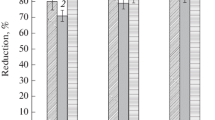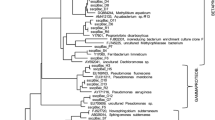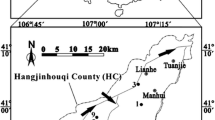Abstract
This chapter illustrates the function of microbes in contaminated groundwater with radioactive waste in the region of Lake Karachai of East Ural, Russia. Since 1951, the lake has been used as a dumping site for low- and intermediate-level liquid radioactive waste of the Mayak Plant Association. Filtration of these solutions through the permeable lake floor resulted in a plume of contaminated groundwater with high concentrations of radionuclides, organic and mineral components such as acetate, oxalate, nitrate, and sulfate. The examined groundwater was sampled from depths of 20–100 m using bore holes, and Eh of the groundwater ranged from +50 to +310 mV; water was slightly alkaline with pH of 7.5–8.0. The water chemistry was characterized with very high concentration of nitrate amounting to 42700 mg/L. Among radionuclides predominated Strontium detected at high concentration in groundwater. The prokaryotic community of groundwater samples was analyzed by cultivation, and cloning-sequencing with 16S rRNA techniques. Due to mostly oxidative conditions in groundwater, high abundance of aerobic bacteria was detected, while the numbers and activity of sulfate-reducing and methanogenic prokaryotes were low. Analysis of the clone libraries of the 16S rRNA genes from weakly contaminated groundwater revealed a diverse microbial community represented mainly by the Patescibacteria (candidate phylum Parcubacteria), Proteobacteria, and by ammonium-oxidizing Thaumarchaeota. About 50 pure cultures isolated from groundwater samples belonged to 23 genera and 33 species of aerobic organotrophs and anaerobic denitrifying and iron-reducing bacteria. The presence of organic carbon sources (acetate), nitrates, and culturable denitrifying prokaryotes suggests a possibility of denitrification in contaminated groundwater. To elucidate microbial function in the absorption of radionuclides some microbial strains isolated from the groundwater were examined.
Access this chapter
Tax calculation will be finalised at checkout
Purchases are for personal use only
Similar content being viewed by others
References
Adkins JP, Cornell LA, Tanner RS (1992) Microbial composition of carbonate petroleum reservoir fluids. Geomicrobiol J 10:87–97
Brunk CF, Avaniss-Aghajani E, Brunk CA (1996) A computer analysis of primer and probe hybridization potential with bacterial small-subunit rRNA sequences. Appl Environ Microbiol 61:872–879
Chicote E, Garcia AN, Moreno DA, Sarro MI, Lorenzo PI, Montero F (2005) Isolation and identification of bacteria from spent nuclear fuel pools. J Ind Microbiol Biotechnol 32:155–162
Drozhko EG, Ivanov IA, Alexakhin AI, Samsonova LM, Glagolev AV (1996a) Current condition of underground hydrosphere at Mayak PA zone. Radiat Saf 1:11–19
Drozhko EG, Ivanov IA, Samsonova LM, Vasilkova NA, Glagolev AV, Ter-Saakyan KS, Zinin AI, Zinina GA (1996b) Hydrogeological conditions near the Lake Karachai and numerical modeling of contaminations in the underground water. Radiat Saf 4:5–14
Duda VI (2011) Ultramicrobacteria. In: eLS. Wiley, Chichester. https://doi.org/10.1002/9780470015902.a0000309.pub2
Elias DA, Krumholz LR, Wong D, Long PE, Suflita JM (2003) Characterization of microbial activities and U reduction in a shallow aquifer contaminated by uranium mill tailings. Microbiol Ecol 46:83–91
Feng C, Huang L, Yu H, Yi X, Wei C (2015) Simultaneous phenol removal, nitrification and denitrification using microbial fuel cell technology. Water Res 76:160–170. https://doi.org/10.1016/j.watres.2015.03.001
Finneran KT, Housewright ME, Lovley DR (2002) Multiple influences of nitrate on uranium solubility during bioremediation of uranium-contaminated subsurface sediments. Environ Microbiol 4:510–516
Garrett RH, Nason A (1969) Further purification and properties of Neurospora nitrate reductase. J Biol Chem 244:2870–2882
Good IJ (1953) The population frequencies of species and the estimation of population parameters. Biometrika 40:237–264
Green SJ, Prakash O, Gihring TM, Akob DM, Jasrotia P, Jardine PM, Watson DB, Brown SD, Palumbo AV, Kostka JE (2010) Denitrifying bacteria isolated from terrestrial subsurface sediments exposed to mixed-waste contamination. Appl Environ Microbiol 76(10):3244–3254
Groβkopf R, Janssen PH, Liesack W (1998) Diversity and structure of the methanogenic community in anoxic rice paddy soil microcosms as examined by cultivation and direct 16S rRNA gene sequence retrieval. Appl Environ Microbiol 64:960–969
Hahn MW, Lang E, Brandt U, Wu QL, Scheuerl T (2009) Emended description of the genus Polynucleobacter and the species P. necessarius and proposal of two subspecies, P. necessarius subspecies necessarius subsp. nov. and P. necessarius subsp. asymbioticus subsp. nov. Int J Syst Evol Microbiol 59:2002–2009
Hahn MW, Schmidt J, Pitt A, Taipale SJ, Lang E (2016) Reclassification of four Polynucleobacter necessarius strains as Polynucleobacter asymbioticus comb. nov., Polynucleobacter duraquae sp. nov., Polynucleobacter yangtzensis sp. nov., and Polynucleobacter sinensis sp. nov., and emended description of the species Polynucleobacter necessarius. Int J Syst Evol Microbiol 66(8):2883–2892
Harris JK, Kelly ST, Pace NR (2004) New perspective on uncultured bacterial phylogenetic division OP11. Appl Environ Microbiol 70(2):845–849
Hatzenpichler R, Lebedeva EV, Spieck E, Stoecker K, Richter A, Daims H, Wagner M (2008) A moderately thermophilic ammonia-oxidizing crenarchaeote from a hot spring. Proc Natl Acad Sci U S A 105:2134–2139
Istok JD, Senko JM, Krumholz LR, Watson D, Bogle MA, Peacock A, Chang Y, White D (2004) In situ bioreduction of technetium and uranium in a nitrate-contaminated aquifer. Environ Sci Technol 38:468–475
Jezbera J, Jezberová J, Brandt U, Hahn MW (2011) Ubiquity of Polynucleobacter necessarius subspecies asymbioticus results from ecological diversification. Environ Microbiol 13(4):922–931
Kantor RS, Wrighton KC, Handley KM, Sharon I, Hug LA, Castelle CJ, Thomas BC, Banfield JF (2013) Small genomes and sparse metabolisms of sediment-associated bacteria from four candidate phyla. mBio 4(5):e00708–e00713. https://doi.org/10.1128/mBio.00708-13.
Kato K, Nagaosa K, Kinoshita T, Kastsuyama C, Nazina TN, Ohnuki T, Kalmykov SN (2020) Microbial ecological function in migration of radionuclides in groundwater. In: Kato K, Konoplev A, Kalmykov SN (eds) Behavior of Radionuclides in the Environment I – Mayak, Vol 1. Springer Nature Singapore Pte Ltd
Koch AL (1994) Most probable numbers. In: Gerhardt P, Murray RGE, Wood WA, Krieg NR (eds) Methods for general and molecular bacteriology. American Society for Microbiology, Washington, DC, pp 257–260
Kolganova TV, Kuznetsov BB, Turova TP (2002) Selection and testing of oligonucleotide primers for amplification sequencing of archaeal 16S rRNA genes. Microbiology (Moscow) 71:283–285
Lloyd JR, Renshaw JC (2005) Bioremediation of radioactive waste: radionuclide–microbe interactions in laboratory and field-scale studies. Curr Opin Biotechnol 16:254–260
Lovley DR, Anderson RT (2000) Influence of dissimilatory metal reduction on fate of organic and metal contaminants in the subsurface. Hydrogeol J 8:77–88
Lovley DR, Phillips EJP (1988) Novel mode of microbial energy metabolism: organic carbon oxidation coupled to dissimilatory reduction of iron or manganese. Appl Environ Microbiol 54:1472–1480
Luk’yanova EA, Zakharova EV, Konstantinova LI, Nazina TN (2008) Sorption of radionuclides by microorganisms from a deep repository of liquid low-level waste. Radiochemistry 50:85–90
Morgenstern A, Choppin GR (2002) Kinetics of the oxidation of Pu(IV) by manganese dioxide. Radiochim Acta 90:69–74
Myasoedov BF, Novikov AP (1999) Radiochemical procedures for speciation of actinides in the environment. Methodology and data obtained in contaminated by radionuclides regions of Russia. In: Proceedings of speciation work shop, October 25–28, 1999, Tokai-Mura, Japan, pp 3–21
Nazina TN, Kosareva IM, Petrunyaka VV, Savushkina MK, Kudriavtsev EG, Lebedev VA, Ahunov VD, Revenko YA, Khafizov RR, Osipov GA, Belyaev SS, Ivanov MV (2004) Microbiology of formation waters from the deep repository of liquid radioactive wastes Severnyi. FEMS Microbiol Ecol 49:97–107
Nazina TN, Shestakova NM, Grigor’yan AA, Mikhailova EM, Tourova TP, Poltaraus AB, Feng C, Ni F, Belyaev SS (2006) Phylogenetic diversity and activity of anaerobic microorganisms of high-temperature horizons of the Dagang oil field (P. R. China). Microbiology (Moscow) 75:55–65
Nazina TN, Luk’yanova EA, Zakharova EV, Konstantinova LI, Kalmykov SN, Poltaraus AB, Zubkov AA (2010) Microorganisms in a disposal site for liquid radioactive wastes and their influence on radionuclides. Geomicrobiol J 27(5):473–486
Newsome L, Morris K, Lloyd JR (2014) The biogeochemistry and bioremediation of uranium and other priority radionuclides. Chem Geol 363:164–184
North NN, Dollhopf SL, Petrie L, Istok JD, Balkwill DL, Kostka JE (2004) Change in bacterial community structure during in situ bio stimulation of subsurface sediment contaminated with uranium and nitrate. Appl Environ Microbiol 70:4911–4920
Novikov AP, Pavlotskaya FI, Goryachenkova TA, Posokhov AK, Kazinskaya IE, Emel’yanov VV, Kuzovkina EV, Barsukova KV, Lavrinovich EA, Korovaikov PA, Drozhko EG, Rovnyi SI, Myasoedov BF (1998) Radionuclide content in underground waters from observation wells around Karachai Lake. Radiokhimiya 40(5):484–490
Novikov AP, Kalmykov SN, Utsunomiya S, Ewing RC, Horreard F, Merkulov A, Clark SB, Tkachev VV, Myasoedov BF (2006) Colloid transport of plutonium in the far-field of the Mayak Production Association, Russia. Science 314(5799):638–641. https://doi.org/10.1126/science.1131307
Pfennig N, Lippert KD (1966) Über das vitamin B12 – Bedürfnis phototropher Schweferelbakterien. Arch Microbiol 55:245–256
Rappe MS, Connon SA, Vergin KL, Giovannoni SJ (2002) Cultivation of the ubiquitous SAR11 marine bacterioplankton clade. Nature 418:630–633
Reigstad LJ, Richter A, Daims H, Urich T, Schwark L, Schleper C (2008) Nitrification in terrestrial hot springs of Iceland and Kamchatka. FEMS Microbiol Ecol 64:167–174
Rinke C, Schwientek P, Sczyrba A, Ivanova NN, Anderson IJ, Cheng JF, Darling A, Malfatti S, Swan BK, Gies EA, Dodsworth JA, Hedlund BP, Tsiamis G, Sievert SM, Liu WT, Eisen JA, Hallam SJ, Kyrpides NC, Stepanauskas R, Rubin EM, Hugenholtz P, Woyke T (2013) Insights into the phylogeny and coding potential of microbial dark matter. Nature 499(7459):431–437. https://doi.org/10.1038/nature12352
Robertson LA, Kuenen JG (1984) Aerobic denitrification: a controversy revived. Arch Microbiol 139:351–354. https://doi.org/10.1007/BF00408378
Robertson LA, van Niel EWJ, Torremans RAM, Kuenen JG (1988) Simultaneous nitrification and denitrification in aerobic chemostat cultures of Thiosphaera pantotropha. Appl Environ Microbiol 54:2812–2818
Rybal’chenko AI, Pimenov MK, Kostin PP, Balukova VD, Nosukhin AV, Mikerin EI, Egorov NN, Kaimin EP, Kosareva IM, Kurochkin VM (1998) Deep injection disposal of liquid radioactive waste in Russia. Battelle Press, Columbus/Richland, p 206
Safonov AV, Babich TL, Sokolova DS, Grouzdev DS, Tourova TP, Poltaraus AB, Zakharova EV, Merkel AY, Novikov AP, Nazina TN (2018a) Microbial community and in situ bioremediation of groundwater by nitrate removal in the zone of a radioactive waste surface repository. Front Microbiol 9:1985. https://doi.org/10.3389/fmicb.2018.01985
Safonov AV, Zakharova EV, Nazina TN, Ponizov AV, Zubkov AA (2018b) Russian experience on microbiological investigation of groundwater from the zone of liquid radioactive waste deep burial. Radioact Waste 3(4):39–50. (in Russian)
Senko JM, Istok JD, Suflita JM, Krumholz LR (2002) In-situ evidence for uranium immobilization and remobilization. Environ Sci Technol 36:1491–1496
Solodov IN, Zotov AV, Khoteev AD, Mukhamet-Galeev AP, Tagirov BR, Apps JA (1998) Geochemistry of natural and contaminated subsurface waters in fissured bed rocks of the Lake Karachai area, Southern Urals, Russia. Appl Geochem 13(8):921–939
Thompson J, Higgins D, Gibson TJ (1994) CLUSTAL W: improving the sensitivity of progressive multiple sequence alignment through sequence weighting, positions-specific gap penalties and weight matrix choice. Nucleic Acids Res 9:3251–3270
Trüper HG, Schlegel HG (1964) Sulfur metabolism in Thiorhodaceae. I. Quantitative measurements on growing cells of Chromatium okenii. Antonie Van Leeuwenhoek 30:225–238
Wall JD, Krumholz LR (2006) Uranium reduction. Annu Rev Microbiol 60:149–166
Weidler GW, Gerbl FW, Stan-Lotter H (2008) Crenarchaeota and their role in the nitrogen cycle in a subsurface radioactive thermal spring in the Austrian Central Alps. Appl Environ Microbiol 74:5934–5942
Weisburg WG, Barns SM, Pelletier DA, Lane DJ (1991) 16S ribosomal DNA amplification for phylogenetic study. J Bacteriol 173:697–703
Widdel F, Bak F (1992) Gram-negative mesophilic sulfate-reducing bacteria. In: Balows A, Trüper HG, Dworkin M, Harder W, Schleifer K-H (eds) The prokaryotes: a handbook on the biology of bacteria: ecophysiology, isolation, identification, application, vol 4, 2nd edn. Springer, New York/Berlin, Heidelberg, pp 3352–3378
Wrighton KC, Castelle CJ, Wilkins MJ, Hug LA, Sharon I, Thomas BC, Handley KM, Mullin SW, Nicora CD, Singh A, Lipton MS, Long PE, Williams KH, Banfield JF (2014) Metabolic interdependencies between phylogenetically novel fermenters and respiratory organisms in an unconfined aquifer. ISME J 8:1452–1463
Xu M, Wu W-M, Wu L, He Z, Van Nostrand JD, Deng Y, Luo J, Carley J, Ginder-Vogel M, Gentry TJ, Gu B, Watson D, Jardine PM, Marsh TL, Tiedje JM, Hazen T, Criddle CS, Zhou J (2010) Responses of microbial community functional structures to pilot-scale uranium in situ bioremediation. ISME J 4:1060–1070
Yarza P, Yilmaz P, Pruesse E, Glöckner FO, Ludwig W, Schleifer KH, Whitman WB, Euzéby J, Amann R, Rosselló-Móra R (2014) Uniting the classification of cultured and uncultured bacteria and archaea using 16S rRNA gene sequences. Nat Rev Microbiol 12:635–645
Zeikus JG, Weimer PJ, Nelson DR, Daniels L (1975) Bacterial methanogenesis: acetate as a methane precursor in pure culture. Arch Microbiol 104:129–134
Acknowledgments
This work was supported by the Russian Foundation for Basic Research (grants No. 11-04-92116 and 13-04-92105), by the Ministry of Science and Higher Education of the Russian Federation, by JSPS and RFBR under the Japan-Russia Research Cooperative Program, by a JSPS KAKENHI Grant Number JP 26257402, and by the Russian Science Foundation (grant No. 17-17-01212).
Author information
Authors and Affiliations
Corresponding author
Editor information
Editors and Affiliations
Rights and permissions
Copyright information
© 2020 Springer Nature Singapore Pte Ltd.
About this chapter
Cite this chapter
Nazina, T.N. et al. (2020). Microbial Diversity and Possible Activity in Nitrate- and Radionuclide-Contaminated Groundwater. In: Kato, K., Konoplev, A., Kalmykov, S. (eds) Behavior of Radionuclides in the Environment I. Springer, Singapore. https://doi.org/10.1007/978-981-15-0679-6_2
Download citation
DOI: https://doi.org/10.1007/978-981-15-0679-6_2
Published:
Publisher Name: Springer, Singapore
Print ISBN: 978-981-15-0678-9
Online ISBN: 978-981-15-0679-6
eBook Packages: Earth and Environmental ScienceEarth and Environmental Science (R0)




